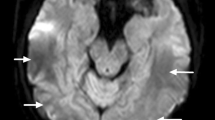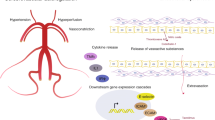Abstract
Purpose
Assess factors in posterior reversible encephalopathy syndrome (PRES) related to intensive care unit (ICU) admissions, mechanical ventilation, and length of stay (LoS).
Methods
Retrospectively, we collected clinical, biochemical, and imaging data of PRES patients. MRI studies were assessed for imaging severity, and complications, including restricted diffusion and hemorrhage. Univariate and multivariate regression analyses were performed for factors associated with ICU admission, mechanical ventilation, and LoS. We assessed for association between clinical and biochemical factors and imaging severity grading systems and complications.
Results
We had 57 subjects with mean ± SD age of 56.3 ± 14.5 years and 68.3% were females. In 60 cases, 36.7% had hypertension, 23.3% had chronic renal disease, 18.3% had sepsis, 16.7% were on active chemotherapy, 10% underwent hematopoietic stem cell transplantation (HSCT), 10% with active cancer, 6.7% were eclampsia/preeclampsia, and 1.7% had radiotherapy. We had 17 (26.6%) grade 1, 26 (46.8%) grade 2, 17 (26.6%) grade 3 PRES based on vasogenic edema extent, and 28 (46.7%) severe PRES (≥ 5 areas) cases. 19 (31.7%) had restricted diffusion with hemorrhage in 19 (31.7%) cases. On multivariate analysis, ICU admissions showed significant association with hypertension (OR = 5.57, 95% CI: 0.96–32.23; p = 0.05), and raised INR (OR = 119, 95% CI: 1.1–1244.3; p = 0.04); LoS with HSCT, mean arterial pressure (MAP), intraparenchymal hematoma, and sepsis; and extent of vasogenic edema with restricted diffusion (OR = 4.31, 95% CI: 1.5–12.33; p < 0.01).
Conclusion
In summary, PRES with hypertension and elevated INR are associated with ICU admissions. HSCT, MAP, intraparenchymal hematoma, and sepsis correlated with LoS. Imaging severity grading based on vasogenic edema extent may be better due to association with restricted diffusion.



Similar content being viewed by others
References
Hinchey J, Chaves C, Appignani B, Breen J, Pao L, Wang A, Pessin MS, Lamy C, Mas JL, Caplan LR (1996) A reversible posterior leukoencephalopathy syndrome. N Engl J Med 334:494–500
Bartynski WS (2008) Posterior reversible encephalopathy syndrome, part 1: fundamental imaging and clinical features. Am J Neuroradiol 29:1036–1042
Bartynski WS (2008) Posterior reversible encephalopathy syndrome, part 2: controversies surrounding pathophysiology of vasogenic edema. Am J Neuroradiol 29:1043–1049
Fugate JE, Claassen DO, Cloft HJ, Kallmes DF, Kozak OS, Rabinstein AA (2010) Posterior reversible encephalopathy syndrome: associated clinical and radiologic findings. Mayo Clin Proc 85:427–432
Granata G, Greco A, Iannella G, Granata M, Manno A, Savastano E, Magliulo G (2015) Posterior reversible encephalopathy syndrome–insight into pathogenesis, clinical variants and treatment approaches. Autoimmun Rev 14:830–836
Chen Z, Shen G-Q, Lerner A, Gao B (2017) Immune system activation in the pathogenesis of posterior reversible encephalopathy syndrome. Brain Res Bull 131:93–99
Gao B, Lyu C, Lerner A, McKinney AM (2018) Controversy of posterior reversible encephalopathy syndrome: what have we learnt in the last 20 years? J Neurol Neurosurg Psychiatry 89:14–20
McKinney AM, Short J, Truwit CL, McKinney ZJ, Kozak OS, SantaCruz KS, Teksam M (2007) Posterior reversible encephalopathy syndrome: incidence of atypical regions of involvement and imaging findings. AJR Am J Roentgenol 189:904–912
Hiremath SB, Anantrao Gautam A, Anil S, Thomas R, Benjamin G (2017) Susceptibility-weighted angiography and diffusion-weighted imaging in posterior reversible encephalopathy syndrome – is there an association between hemorrhage, cytotoxic edema, blood pressure and imaging severity? J Neuroradiol 44:319–325
Schweitzer AD, Parikh NS, Askin G, Nemade A, Lyo J, Karimi S, Knobel A, Navi BB, Young RJ, Gupta A (2017) Imaging characteristics associated with clinical outcomes in posterior reversible encephalopathy syndrome. Neuroradiol 59:379–386
Legriel S, Schraub O, Azoulay E et al (2012) Determinants of recovery from severe posterior reversible encephalopathy syndrome. PLoS One 7:e44534
Siebert E, Bohner G, Liebig T, Endres M, Liman TG (2017) Factors associated with fatal outcome in posterior reversible encephalopathy syndrome: a retrospective analysis of the Berlin PRES study. J Neurol 264:237–242
Alhilali LM, Reynolds AR, Fakhran S (2014) A multi-disciplinary model of risk factors for fatal outcome in posterior reversible encephalopathy syndrome. J Neurol Sci 347:59–65
Junewar V, Verma R, Sankhwar PL, Garg RK, Singh MK, Malhotra HS, Sharma PK, Parihar A (2014) Neuroimaging features and predictors of outcome in eclamptic encephalopathy: a prospective observational study. AJNR Am J Neuroradiol 35:1728–1734
Chen Z, Zhang G, Lerner A, Wang A-H, Gao B, Liu J (2018) Risk factors for poor outcome in posterior reversible encephalopathy syndrome: systematic review and meta-analysis. Quant Imaging Med Surg 8:421–432
Covarrubias DJ, Luetmer PH, Campeau NG (2002) Posterior reversible encephalopathy syndrome: prognostic utility of quantitative diffusion-weighted MR images. AJNR Am J Neuroradiol 23:1038–1048
Pilato F, Calandrelli R, Distefano M, Panfili M, Della Marca G, Colosimo C (2019) Acute radiological pattern and outcome in posterior reversible encephalopathy syndrome patients. Clin Neurol Neurosurg 185:105459
Hinduja A, Habetz K, Raina S, Ramakrishnaiah R, Fitzgerald RT (2017) Predictors of poor outcome in patients with posterior reversible encephalopathy syndrome. Int J Neurosci 127:135–144
Hinduja A, Habetz K, Raina SK, Fitzgerald RT (2017) Predictors of intensive care unit utilization in patients with posterior reversible encephalopathy syndrome. Acta Neurol Belg 117:201–206
Lee VH, Wijdicks EFM, Manno EM, Rabinstein AA (2008) Clinical spectrum of reversible posterior leukoencephalopathy syndrome. Arch Neurol 65:205–210
Burnett MM, Hess CP, Roberts JP, Bass NM, Douglas VC, Josephson SA (2010) Presentation of reversible posterior leukoencephalopathy syndrome in patients on calcineurin inhibitors. Clin Neurol Neurosurg 112:886–891
Liman TG, Bohner G, Endres M, Siebert E (2014) Discharge status and in-hospital mortality in posterior reversible encephalopathy syndrome. Acta Neurol Scand 130:34–39
Donmez FY, Agildere AM (2015) Recurrent childhood PRES. Neurol Sci 36:1603–1609
Hinduja A (2020) Posterior reversible encephalopathy syndrome: clinical features and outcome. Front Neurol 11:71
Fischer M, Schmutzhard E (2017) Posterior reversible encephalopathy syndrome. J Neurol 264:1608–1616
Marfil-Garza BA, Belaunzarán-Zamudio PF, Gulias-Herrero A, Zuñiga AC, Caro-Vega Y, Kershenobich-Stalnikowitz D, Sifuentes-Osornio J (2018) Risk factors associated with prolonged hospital length-of-stay: 18-year retrospective study of hospitalizations in a tertiary healthcare center in Mexico. PLoS One 13:e0207203
Toptas M, Sengul Samanci N, Akkoc İ, Yucetas E, Cebeci E, Sen O, Can MM, Ozturk S (2018) Factors affecting the length of stay in the intensive care unit: our clinical experience. BioMed Res Int 2018:9438046
Stewart S, Robertson C, Pan J et al (2021) Impact of healthcare-associated infection on length of stay. J Hosp Infect 114:23–31
Wong DT, Gomez M, McGuire GP, Kavanagh B (1999) Utilization of intensive care unit days in a Canadian medical-surgical intensive care unit. Crit Care Med 27:1319–1324
Hefzy HM, Bartynski WS, Boardman JF, Lacomis D (2009) Hemorrhage in posterior reversible encephalopathy syndrome: imaging and clinical features. Am J Neuroradiol 30:1371–1379
Racchiusa S, Mormina E, Ax A, Musumeci O, Longo M, Granata F (2019) Posterior reversible encephalopathy syndrome (PRES) and infection: a systematic review of the literature. Neurol Sci Off J Ital Neurol Soc Ital Soc Clin Neurophysiol 40:915–922
Li K, Yang Y, Guo D, Sun D, Li C (2020) Clinical and MRI features of posterior reversible encephalopathy syndrome with atypical regions: a descriptive study with a large sample size. Front Neurol 11:194
Gao B, Yu BX, Li RS, Zhang G, Xie HZ, Liu FL, Lv C (2015) Cytotoxic edema in posterior reversible encephalopathy syndrome: correlation of MRI features with serum albumin levels. Am J Neuroradiol 36:1884–1889
Pirker A, Kramer L, Voller B, Loader B, Auff E, Prayer D (2011) Type of edema in posterior reversible encephalopathy syndrome depends on serum albumin levels: an MR imaging study in 28 patients. Am J Neuroradiol 32:527–531
Siebert E, Bohner G, Endres M, Liman TG (2014) Clinical and radiological spectrum of posterior reversible encephalopathy syndrome: does age make a difference? – A retrospective comparison between adult and pediatric patients. PLoS One 9:e115073
Cruz RJ, DiMartini A, Akhavanheidari M, Iacovoni N, Boardman JF, Donaldson J, Humar A, Bartynski WS (2012) Posterior reversible encephalopathy syndrome in liver transplant patients: clinical presentation, risk factors and initial management. Am J Transplant Off J Am Soc Transplant Am Soc Transpl Surg 12:2228–2236
Pande AR, Ando K, Ishikura R, Nagami Y, Takada Y, Wada A, Watanabe Y, Miki Y, Uchino A, Nakao N (2006) Clinicoradiological factors influencing the reversibility of posterior reversible encephalopathy syndrome: a multicenter study. Radiat Med 24:659–668
McKinney AM, Sarikaya B, Gustafson C, Truwit CL (2012) Detection of microhemorrhage in posterior reversible encephalopathy syndrome using susceptibility-weighted imaging. Am J Neuroradiol 33:896–903
Karia SJ, Rykken JB, McKinney ZJ, Zhang L, McKinney AM (2016) Utility and significance of gadolinium-based contrast enhancement in posterior reversible encephalopathy syndrome. AJNR Am J Neuroradiol 37:415–422
Author information
Authors and Affiliations
Contributions
All authors attest that they meet the current International Committee of Medical Journal Editors (ICMJE) criteria for Authorship.
Corresponding author
Ethics declarations
Conflict of interest
The authors declare no competing interests.
Ethical approval
The ethics approval was obtained from the institutional Research and Ethics Board (REB: 20190724-01H).
Informed consent
The REB granted a waiver for the Informed consent from all individual participants included in the study.
Additional information
Publisher's note
Springer Nature remains neutral with regard to jurisdictional claims in published maps and institutional affiliations.
Supplementary Information
Below is the link to the electronic supplementary material.
Rights and permissions
About this article
Cite this article
Hiremath, S.B., Massicotte-Tisluck, K. & Chakraborty, S. Factors affecting hospitalization, imaging severity, and complications in posterior reversible encephalopathy syndrome. Neurol Sci 43, 6461–6470 (2022). https://doi.org/10.1007/s10072-022-06271-w
Received:
Accepted:
Published:
Issue Date:
DOI: https://doi.org/10.1007/s10072-022-06271-w




